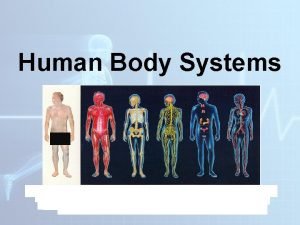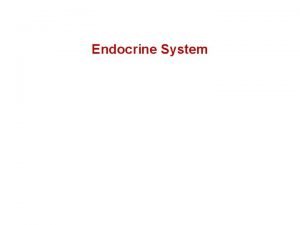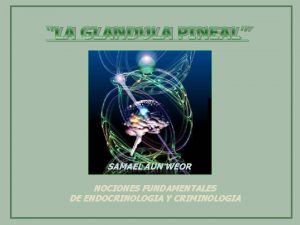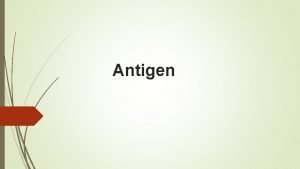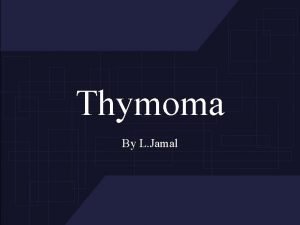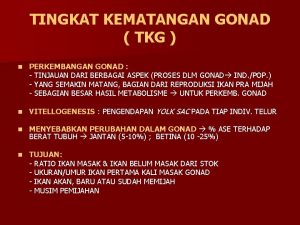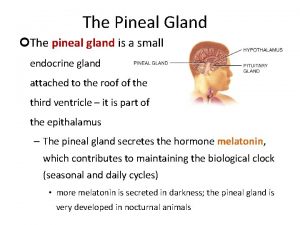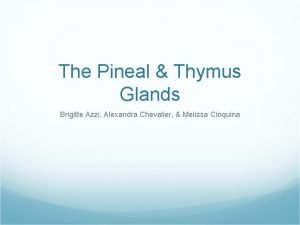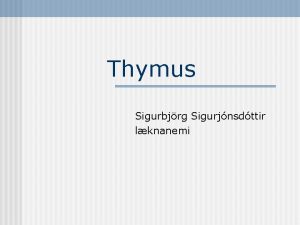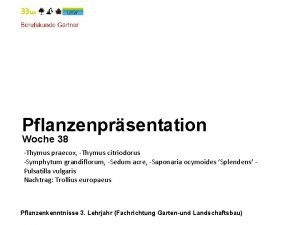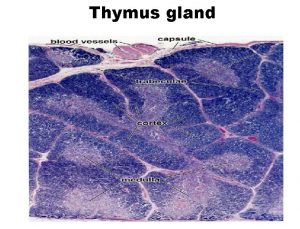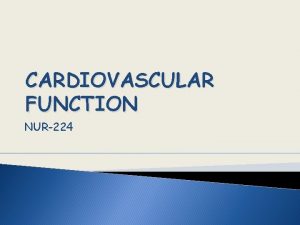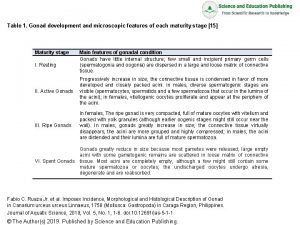The AnatomyPhysiology of the Gonad Pineal and Thymus


















- Slides: 18

The Anatomy/Physiology of the Gonad, Pineal, and Thymus Glands By Hayley Stevenson, Alondra Beltran, Giovanni Villegas, Analisa Guzman

Gonads: Basic Anatomy/Location ❖ Basic Anatomy ➢ The gonads are considered the primary organs of the reproductive system ➢ These glands produce eggs in females and sperm cells in males ❖ Location ➢ A pair of gonads are found in both female and male reproductive systems ➢ Female gonads are found in the ovaries

Gonads: General Function and Secretions ❖ General function of gonads and their secretions ➢ Female gonads secrete estrogen and progesterone ■ Estrogen introduces secondary sex characteristics at puberty ➢ Maintains and matures the reproductive organs ➢ Progesterone promotes menstrual cycle changes ➢ Male gonads produce testosterone ➢ Introduces secondary sexual characteristics at puberty

Gonads: Disease/Abnormalities ❖ Ovarian Diseases and abnormalities ❖ Osteoporosis: Menopause and mood swings ❖ Ovarian Cancer: - Symptoms become noticeable in later stages ➢ Very rare ❖ Ovarian Cysts: ➢ Fluid filled sacs ➢ Can range from the size of a pea to a grapefruit.

Polycystic ovary Ovary with Cyst

Gonads: Disease/ abnormalities ❖ Testes diseases and abnormalities ❖Testicular trauma: -prone to injury ❖Testicular cancer: -abnormal growth of cells in testicles grow in an uncontrollable rate ❖ Hypogonadism: Gonads do not produce enough testosterone ❖ Epididymitis ➢inflammation of the epididymis


Pineal Gland: Basic Anatomy/Location ❖ Basic anatomy ➢ 5 -9 mm long; weighs. 1 grams ➢ This gland is composed of neuroglial cells, neurons, and pinealocytes ■ pinealocytes are a type of endocrine cell ❖ Location ➢ located on the back portion of the third cerebral ventricle of the brain

Pineal Gland: General Function and Secretions ❖ Functions of the pineal gland its secretion ➢ secretes melatonin ■ regulates female reproduction and sexual maturation ■ controls the body’s internal clock ➢ Not all of the functions of the pineal gland have been discovered yet

The Pineal Glands: Disease/Abnormalities ❖ Pineal Disorders ➢ Pineal gland tumors. ➢ seasonal affective disorder -Lack or absence of light during winter ➢ Caused by abnormal excretion of Melatonin ■ person is exposed little light during day or too much light during night ■ Jet lag


Thymus Gland: Basic Anatomy ❖ Basic Anatomy ➢ Tissues ■ adipose, epithelial/glandular tissue ➢ The thymus is active until puberty, and begins to shrink, and becomes inactive, then turns to fat ➢ two thymic lobes ■ right/left ➢ composed of septae (divides a cavity/structure into smaller ones)

Thymus Gland: Location ❖ Location ➢ The Thymus gland is located behind your sternum and between your lungs

Thymus Gland: General Function and Secretions ❖ The thymus produces thymosin ➢ Thymosin stimulates the development of T-cells ➢ During your childhood, white blood cells called lymphocytes pass through the thymus gland are turned into T cells ❖ Lymphocytes aid the immune system in fighting disease ❖ The thymus produces all of the lymphocytes before puberty is finished

Thymus disease and abnormalities ❖ Thymic Carcinoma ➢ Most aggressive cancer that can develop in this region ➢ Difficult to treat ➢ Typically accompanies an autoimmune disease ❖ Severe Combined immunodeficiency ➢ Develops when a person carries a mutation from birth ➢ Compromises T-Cell regulation and immune system


Works Cited ❖ "SEER: Training Gonads. " National Cancer Institute. Web. 21 Feb. 2016. ➢ <http: //training. seer. cancer. gov/anatomy/endocrine/glands/gonads. html>. ❖ Sargis, Robert M. "An Overview of the Thymus. " Endocrineweb. 10 July 2014. Web. 21 Feb. 2016. ➢ <http: //www. endocrineweb. com/endocrinology/overview-thymus> ❖ Herndon, Jamie. "Thymus Cancer. " Healthline. 16 Feb. 2016. Web. 22 Feb. 2016. ➢ <http: //www. healthline. com/health/thymus-cancer#Overview 1> ❖ Sargid, Robert M. "An Overview of the Ovaries. " Endocrine Web. 21 Feb. 2016. ➢ <http: //www. endocrineweb. com/endocrinology/overview-ovaries>. ❖ Singha, Rajib. "Pineal Gland Disorders. " Buzzle. 2 Sept. 2011. Web. 21 Feb. 2016.

The End
 Pituitary gland and pineal gland spiritual
Pituitary gland and pineal gland spiritual Pineal and pituitary glands
Pineal and pituitary glands Pineal and pancreas glands
Pineal and pancreas glands Secretin target organ
Secretin target organ Seat of the soul pineal gland
Seat of the soul pineal gland Fisiologia de la glandula pineal
Fisiologia de la glandula pineal Pineal gland secretes
Pineal gland secretes Thyoid gland
Thyoid gland Thyroid parafollicular cells
Thyroid parafollicular cells Olho de horus e glandula pineal
Olho de horus e glandula pineal Uzunsov beyin
Uzunsov beyin Dr atiar rahman
Dr atiar rahman Thymus coupe histologique
Thymus coupe histologique Cabcde
Cabcde Thymus independent antigens
Thymus independent antigens Thymus independent antigens
Thymus independent antigens Thymus baby chest x ray
Thymus baby chest x ray Thymus galnd
Thymus galnd Appendix secondary lymphoid organ
Appendix secondary lymphoid organ


